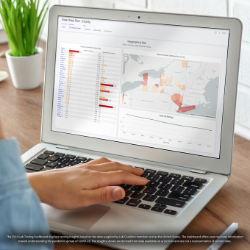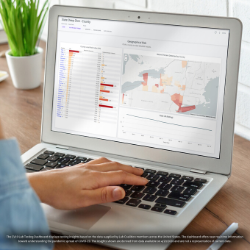
“The Local Risk Index highlights hot spots where the virus is accelerating in a dramatic way.”
INDIANAPOLIS (PRWEB)
April 23, 2020
Today, hc1 announced a powerful Local Risk Index (LRI) now available within cv19dashboard.org that delivers at-a-glance analysis of accelerating or decelerating COVID-19 infection rates by county and Public Use Microdata Area (PUMA).
“Healthcare planners will be alerted to where and when action must occur,” said Peter Plantes, M.D., hc1 Physician Executive. “Based on the known average clinical course of COVID-19 (from incubation to potential ICU-transfer and ventilation), timely, local data visualization enables users to predict 5 to 21 days in advance an acceleration of patient volumes with symptomatic COVID-19, and the associated increase in local demand for COVID-19 care resources like ER visits, hospitalizations, and ICU transfers.”
A clinical advisory team of epidemiological and healthcare experts advised hc1 in developing the LRI. “The Local Risk Index highlights hot spots where the virus is accelerating in a dramatic way. And if the LRI is falling then the virus spread is decelerating within the selected population area. Public health officials and hospitals can respond accordingly to these realtime objective measurements from the community,” said Richard Olds, MD, MCAP, International Expert – Infectious Diseases, Former U.S. Medical School Dean. “Think of it like a pollen count. If your local county has a high pollen score, then you’re more likely to develop active allergy symptoms.”
Anonymized trending data from a coalition of more than 20,000 lab testing locations supports the COVID-19 Lab Testing Dashboard’s Local Risk Index, as well as visualizations of COVID-19 testing rates, positive and negative test results, and key demographic filters like age and gender down to the county and sub-county (Public Use Microdata Area) level. Approximately 40 percent of the national COVID-19 lab testing results are reflected in the dashboard’s insights.
“Partners across the country have told us health systems and public health officials need more timely and granular insight to better plan for and address the needs of the CV-19 pandemic,” said Brad Bostic, hc1 CEO. “hc1’s core business focuses on transforming lab data into personalized healthcare insights. Given our unique assets and capabilities, we mobilized our team and lab coalition partners to quickly deliver a critical component of national surveillance infrastructure that addresses these challenges.”
The CV19 Lab Testing Dashboard powered by hc1 is a free public health service for individuals directly involved with implementing policies and delivering care to mitigate the spread of COVID-19. Included are public health officials, government agencies, and healthcare providers. Qualified individuals need only request access at cv19dashboard.org.
All trends in the dashboard are based on de-identified, aggregated data in accordance with the Health Insurance Portability and Accountability Act (HIPAA) privacy requirements. Accredited COVID-19 testing labs are encouraged to learn more and support this important public health initiative by visiting cv19dashboard.org/join.html.
About hc1®
Founded to improve lives with high-value care, hc1 has emerged as the leader in bioinformatics for precision testing and prescribing. The cloud-based hc1 High-Value Care Platform® organizes volumes of live data, including lab results, genomics, and medications, to deliver solutions that ensure that the right patient gets the right test and the right prescription. Today, the hc1 Platform powers solutions that optimize diagnostic testing and prescribing for millions of patients nationally. To learn more about hc1’s proven approach to personalizing care while eliminating waste for thousands of health systems, diagnostic laboratories, and health plans, visit http://www.hc1.com and follow us on Twitter, Facebook, and LinkedIn.
Share article on social media or email:

